Technical Limits in Prescriptive Building Cultures and Tectonic Approaches: Challenges of Turkish Cypriot Architects
Abstract
1. Introduction
- (a)
- technical viewpoints intertwined with prescriptive measures that promote conservative organisational traits in design, discourage critical thinking, and limit innovative attitudes;
- (b)
- design attitudes to tectonics and innovation.
- (1)
- Affirmative Approach to Tectonics: This approach accepts PTLs as a limiting framework for innovative tectonic solutions, without aiming for such design challenges. In this tectonic design approach, architects work within the technical boundaries of nature and within the limits set by authorities to enhance structural qualities [29]. As described by Frampton [30], the ontological approach to tectonics requires mindsets aligned with natural requirements, such as cutting timber parallel to its linear texture. Here, the affirmative approach may encompass both Frampton’s ontological approach to tectonics and the prescriptive approach, which dictates correct or required solutions imposed by building codes, structural engineers, and contractors, among others. Hurol [14] emphasises that PTLs, especially in seismic zones, dictate architectural decisions that critically affect the adoption of innovative solutions to minimise the risk of technical problems, often due to a lack of knowledge. However, the affirmative tectonic approach is evident worldwide, including in disaster-prone regions. To achieve tectonic and architectural values, architects adhering to this approach must maintain tectonic values while avoiding mechanistic instrumentality in building production. In this way, the approach can offer its audience a positive aesthetic experience. Focusing more on the design of the façade and interior spaces, Johnson and Burgee’s preference for a standard frame structure in the AT&T Building represents a modest adherence to engineering recommendations for the economic design of high-rise frame systems, with no intention of making technical or technological improvements to the design; therefore, no innovative structural approach is introduced.
- (2)
- Contravening Approach to Tectonics: This approach typically occurs in the absence of PTLs. However, it can also challenge and transform PTLs or reject their limitations to improve them through innovative attitudes. Architects adopt a free approach by using new materials, systems, techniques, and forms to push design boundaries. Referring to Bachelard [31], Hurol [14,29] aligns this with rapid tectonic shifts, describing it as ‘playing with fire, like Prometheus’, where innovation thrives on intellectual engagement with limits. The Beijing Water Cube, designed by PTW Architects, CSCEC, CCDI, and Arup, and opened in 2008, is a notable example of contravening architecture. When the building won the architectural competition, its unique space frame structure was unknown to structural engineers. Also, the translucent bubbles (ETFE) on its façade were unknown as a façade material. Both were developed after the building won the competition. The architecture of this building necessitated scientific research, resulting in several innovations.
2. Research Problem and Limits
- (a)
- How do UCTCEA architects identify the PTLs of reinforced-concrete frame structures in their professional experiences?
- (b)
- What types of PTLs related to reinforced-concrete frame structures do they encounter and experience during the building process?
- (c)
- If they realize such PTLs in their professional practice, by which tendencies do they approach them? Finding a way to ignore them? Fighting against them? Challenging them? Giving up on facing them? Interpreting them in other ways? Or other ways?
3. Research Methodology
- Structural Coding to deductively identify PTL initiators and stages where PTLs manifest,
- Descriptive Coding to deductively specify PTLs and root causes,
- Value Coding to inductively capture PTL effects on architects’ practice and tectonic approaches (affirmative and contravening, outlined in Table 1),
- Thematic analysis answering the research questions.
- (1)
- Periodic revisions to earthquake design codes (e.g., TEC 2007; 2019) periodically intensify prescriptive requirements and can trigger mid-project design updates. These cycles compress time available for exploration and favor risk-averse solutions.
- (2)
- Structural coding shows that PTLs most frequently emerge early—during Preliminary Design—and re-intensify during Construction Documentation and the Project Visa Application, when compliance and third-party checks are most binding. At the Construction stage, contractors’ preferences and standardization further reduce flexibility.
- (3)
- Late-stage detailing often offers only incremental room for adaptation; once permits and documentation are complete, deviations entail time and cost penalties, reinforcing affirmative approaches over contravening ones.
3.1. Study Setting
3.2. Temporal Framework
3.3. Participant Characterization
4. Building Prescriptive Measures and PTLs
- No freedom and limited flexibility in addressing design problems;
- Constraints on architectural and structural innovative solutions and/or approaches;
- Minimal requirement for architects to consider the implications of design decisions;
- Greater monitoring and control during construction, particularly in seismic regions;
- Potential compromise of aesthetic approach and cost-effectiveness;
- Delays in adopting PTLs due to standardisations in the evaluation of submitted projects;
- Difficulties in optimising costs during the building process.
5. Findings
5.1. Structural Coding of Data Set: Initiators and Stages of PTLs
5.2. Descriptive Coding of Data Set: Types of PTLs and Their Root Causes
5.3. Value Coding of Data Set: Effects of PTLs on Design and UCTCEA Architects’ Approaches
5.4. Tectonic Approaches in the Practice of UCTCEA Architects
5.4.1. Affirmative Tectonic Approach
5.4.2. Contravening Tectonic Approach
- (a)
- structural system-level contravening (limited, contingent on early collaboration and regulatory negotiation);
- (b)
- micro-scale contravening in structural detailing/1:1-scale refinement, which remains more feasible within prescriptive envelopes.
6. Discussions on Research Thematic Constructs
- Institutional control aligned with conservative measures;
- Promoting conformity with norms;
- Prioritizing functionality and safety;
- Ensuring uniformity and diminishing experiential technical values in design;
- Restricting the exploration of innovative alternatives and limiting creative independence.
6.1. Comparative Integration and Benchmarking
6.1.1. Context Effects
6.1.2. Transferability
7. Conclusions
- ‘Direct’ pressures (place/time/user) favour affirmative tectonic solutions in most reviewed projects, reflecting the conservative, tightly regulated prescriptive building culture in Northern Cyprus, where norms and control mechanisms discourage innovative tectonic design by promoting structural and technical conservatism;
- ‘Indirect’ looped influences across individual–organisational–technical scales make contravening tectonic approaches difficult (scale loop).
Author Contributions
Funding
Institutional Review Board Statement
Informed Consent Statement
Data Availability Statement
Acknowledgments
Conflicts of Interest
Abbreviations
| PTL | Prescriptive Technical Limit |
| SED | Mixed Method Research of Sequential Explanatory Design |
| TBEC2018 | Turkish Building Earthquake Code-2018 |
| TEC2007 | Turkish Earthquake Code-2007 |
| UCTCEA | The Union of Chambers of Turkish Cypriot Engineers and Architects |
References
- Marcuse, H. One-Dimensional Man: Studies in the Ideology of Advanced Industrial Society; Beacon Press: Boston, MA, USA, 1964. [Google Scholar]
- Stenner, K. The Authoritarian Dynamic; Cambridge University Press: New York, NY, USA, 2005. [Google Scholar]
- Jost, J.; van der Toorn, J. System justification theory. In Handbook of Theories of Social Psychology; Van Lange, P., Kruglanski, A., Higgins, E., Eds.; Sage Publications Ltd.: New Delhi, India, 2012; Volume 2, pp. 313–343. [Google Scholar]
- Al-Khatib, A.W.; Al-Fawaeer, M.A.; Alajlouni, M.I.; Rifai, F.A. Conservative culture, innovative culture, and innovative performance: A multi-group analysis of the moderating role of the job type. Int. J. Innov. Sci. 2022, 14, 675–692. [Google Scholar] [CrossRef]
- Koolhaas, R. Delirious New York: A Retroactive Manifesto for Manhattan; Oxford University Press: New York, NY, USA, 1978. [Google Scholar]
- Rossi, A.; Eisenman, P. The Architecture of the City; MIT Press: Cambridge, MA, USA, 1982. [Google Scholar]
- Tafuri, M. Architecture and Utopia: Design and Capitalist Development; MIT Press: Cambridge, MA, USA, 1976. [Google Scholar]
- Wigley, M. Constant’s New Babylon: The Hyper-Architecture of Desire; 010 Publishers: Rotterdam, The Netherlands, 1998. [Google Scholar]
- Markus, T. Buildings and Power: Freedom and Control in the Origin of Modern Building Types; Routledge: London, UK, 1993. [Google Scholar]
- Spencer, D. The Architecture of Neoliberalism: How Contemporary Architecture Became an Instrument of Control and Compliance; Bloomsbury Academic: New York, NY, USA, 2016. [Google Scholar]
- Easterling, K. Extrastatecraft: The Power of Infrastructure Space; Verso: London, UK, 2014. [Google Scholar]
- Aureli, P.V. The Project of Autonomy: Politics and Architecture Within and Against Capitalism; Princeton Architectural Press: New York, NY, USA, 2008. [Google Scholar]
- Gülkan, P.; Reitherman, R.K. Building codes and standards. In Encyclopedia of Earthquake Engineering; Springer: Berlin/Heidelberg, Germany, 2014; pp. 1–14. [Google Scholar]
- Hurol, Y. Tectonic Affects in Contemporary Architecture; Cambridge Scholars Publishing: Newcastle upon Tyne, UK, 2022. [Google Scholar]
- Ching, F.D.K.; Winkel, S. Building Codes Illustrated: A Guide to Understanding the 2015 International Building Code; John Wiley & Sons: Hoboken, NJ, USA, 2016. [Google Scholar]
- Artemeva, V. The future architects’ attitude towards innovations in the context of sustainable development. Discourse Commun. Sustain. Educ. 2014, 5, 31–37. [Google Scholar] [CrossRef]
- Bondarenko, I.A. On the traditional attitude towards architectural innovation. In Proceedings of the 2nd International Conference on Architecture: Heritage, Traditions and Innovations (AHTI 2020), Paris, France, 23 September 2020. [Google Scholar]
- Smith, K.G. Innovation in earthquake resistant concrete structure design philosophies: A century of progress since Hennebique’s patent. Eng. Struct. 2001, 23, 72–81. [Google Scholar] [CrossRef]
- Nazidizaji, S.; Tomé, A.; Regateiro, F. Levels of innovation in architectural design. Rev. Lusófona Arquit. Educ. 2014, 11, 519–534. [Google Scholar]
- Felder, M.; Kleinhout-Vliek, T.; Stevens, M.; de Bont, A. From ‘if only’ to ‘what if’: An ethnographic study into design thinking and organizational change. Des. Stud. 2023, 86, 101178. [Google Scholar] [CrossRef]
- Wrigley, C.; Nusem, E.; Straker, K. Implementing design thinking: Understanding organizational conditions. Calif. Manag. Rev. 2020, 62, 125–143. [Google Scholar] [CrossRef]
- Altshuller, G.; Shapiro, R. The psychology of inventive creativity. Issues Psychol. 1956, 6, 37–49. [Google Scholar]
- Henderson, R.M.; Clark, K.B. Architectural innovation: The reconfiguration of existing product technologies and the failure of established firms. Adm. Sci. Q. 1990, 35, 9–30. [Google Scholar] [CrossRef]
- Nigra, M.; Dimitrijevic, B. Is radical innovation in architecture crucial to sustainability? Lessons from three Scottish contemporary buildings. Archit. Eng. Des. Manag. 2018, 14, 272–291. [Google Scholar] [CrossRef]
- Becerik-Gerber, B.; Gerber, D.; Ku, K. The pace of technological innovation in architecture, engineering, and construction education: Integrating recent trends into the curricula. J. Inf. Technol. Constr. 2011, 16, 411–432. [Google Scholar]
- Idi, D.B.; Khaidzir, K.A.B.M. Concept of creativity and innovation in architectural design process. Int. J. Innov. Manag. Technol. 2015, 6, 16–20. [Google Scholar] [CrossRef]
- Mainstone, R.J. Structure in Architecture: History, Design and Innovation; Routledge: London, UK, 1999. [Google Scholar]
- Brookes, A.J.; Poole, D. Innovation in Architecture: A Path to the Future; Spon Press: London, UK; New York, NY, USA, 2004. [Google Scholar]
- Hurol, Y. The Tectonics of Structural Systems: An Architectural Approach, 1st ed.; Routledge: London, UK, 2016. [Google Scholar] [CrossRef]
- Frampton, K. Studies in Tectonic Culture: The Poetics of Construction in Nineteenth and Twentieth Century Architecture; Cava, J., Ed.; MIT Press: Cambridge, MA, USA, 2001. [Google Scholar]
- Bachelard, G. The Psychoanalysis of Fire; Beacon Press: Boston, MA, USA, 1964. [Google Scholar]
- Imrie, R.; Street, E. Autonomy and the socialisation of architects. J. Archit. 2014, 19, 723–739. [Google Scholar] [CrossRef]
- Imrie, R.; Street, E. Architectural Design and Regulation; Wiley-Blackwell: Malden, MA, USA, 2011. [Google Scholar]
- Imrie, R. The interrelationships between building regulations and architects’ practices. Environ. Plann. B 2007, 34, 925–943. [Google Scholar] [CrossRef]
- Morgan, G.; Engwall, L. Regulation, risk and organizations: An introduction. In Regulation and Organisations: International Perspectives; Morgan, G., Engwall, L., Eds.; Routledge: London, UK, 1999; pp. 1–14. [Google Scholar]
- Fauth, J.; Nørkjær Gade, P.; Kaiser, S.; Raj, K.; Goul Pedersen, J.; Olsson, P.-O.; Nisbet, N.; Mastrolembo Ventura, S.; Hirvensalo, A.; Granja, J.; et al. Investigating building permit processes across Europe: Characteristics and patterns. Build. Res. Inf. 2025, 53, 417–434. [Google Scholar] [CrossRef]
- UCTCEA. UCTCEA Members. Available online: https://www.mimarlarodasi.org/ (accessed on 14 February 2022).
- Driscoll, D.L.; Appiah-Yeboah, A.; Salib, P.; Rupert, D.J. Merging qualitative and quantitative data in mixed methods research: How to and why not. Ecol. Environ. Anthropol. 2007, 3, 19–28. [Google Scholar]
- Creswell, J.W. Qualitative Inquiry & Research Design: Choosing Among Five Approaches; SAGE: Thousand Oaks, CA, USA, 1998. [Google Scholar]
- Ivankova, N.V.; Creswell, J.W.; Stick, S.L. Using mixed-methods sequential explanatory design: From theory to practice. Field Methods 2006, 18, 3–20. [Google Scholar] [CrossRef]
- Creswell, J.W. Research Design: Qualitative, Quantitative, and Mixed Methods Approaches; SAGE: Thousand Oaks, CA, USA, 2003. [Google Scholar]
- TEC. Turkish Earthquake Design Code, Ministry of Public Works and Settlement; Government of Republic of Turkey: Ankara, Turkey, 2007. [Google Scholar]
- Kvale, S. InterViews: An Introduction to Qualitative Research Interviewing; SAGE: Thousand Oaks, CA, USA, 1996. [Google Scholar]
- Williams, M.; Moser, T. The art of coding and thematic exploration in qualitative research. Int. Manag. Rev. 2019, 15, 45–55. [Google Scholar]
- Maguire, M.; Delahunt, B. Doing a thematic analysis: A practical, step-by-step guide for learning and teaching scholars. All Irel. J. High. Educ. 2017, 8, 1–14. [Google Scholar]
- Alhojailan, M.I. Thematic analysis: A critical review of its process and evaluation. West East J. Soc. Sci. 2012, 1, 39–47. [Google Scholar]
- Aliakbarlou, S.; Wilkinson, S.; Ben, S. Exploring construction client values and qualities: Are these two distinct concepts in construction studies? Built Environ. Proj. Asset Manag. 2017, 7, 234–252. [Google Scholar] [CrossRef]
- Lam, P.T.; Wong, F.W. A comparative study of buildability perspectives between clients, consultants and contractors. Constr. Innov. 2011, 11, 305–320. [Google Scholar] [CrossRef]
- Boyd, D.; Chinyio, E. Understanding the Construction Client; Blackwell Publishing: Oxford, UK, 2006. [Google Scholar]
- Blyth, A.; Worthington, J. Managing the Brief for Better Design, 1st ed.; Taylor & Francis: London, UK, 2002. [Google Scholar]
- Ching, F.D.K. Building Construction Illustrated; John Wiley & Sons: Hoboken, NJ, USA, 2014. [Google Scholar]
- Foliente, G.C. Developments in performance-based building codes and standards. For. Prod. J. 2000, 50, 12–21. [Google Scholar]
- Johnson, M.A. Referenced Standards and The International Codes. Available online: https://www.astm.org/SNEWS/DECEMBER_2003/johnson_dec03.html (accessed on 12 April 2018).
- Pedro, J.B.; Meijer, F.; Visscher, H. Technical Building Regulations in EU Countries: A Comparison of Their Organization and Formulation; CIB World Congress 2010—Building a Better World: Salford, UK, 2010. [Google Scholar]
- Hartoonian, G. Ontology of Construction: On Nihilism of Technology in Theories of Modern Architecture; Cambridge University Press: Cambridge, UK, 1994. [Google Scholar]
- Sekler, E.F. Structure, construction, tectonics. In Structure in Art and in Science; Kepes, G., Ed.; George Braziller: New York, NY, USA, 1965; pp. 89–95. [Google Scholar]
- Bötticher, K. The Tectonics of the Hellenes; Creative Media Partners, LLC.: Potsdam, Germany, 1852. [Google Scholar]
- TBEC. Turkey Building Earthquake Code; Republic of Turkey Ministry of Interior Disaster and Emergency Management Authority: Ankara, Turkey, 2018. [Google Scholar]
- Bassurucu, M.; Yildiz, O.; Kina, C. Seismic Performance Assessment of an RC Building Due to 2023 Türkiye Earthquakes: A Case Study in Adıyaman, Türkiye. Buildings 2025, 15, 521. [Google Scholar] [CrossRef]
- Mertol, H.C.; Tunç, G.; Akış, T.; Kantekin, Y.; Aydın, İ.C. Investigation of RC Buildings after 6 February 2023, Kahramanmaraş, Türkiye Earthquakes. Buildings 2023, 13, 1789. [Google Scholar] [CrossRef]
- Zeng, B.; Li, Y. Towards Performance-Based Design of Masonry Buildings: Literature Review. Buildings 2023, 13, 1534. [Google Scholar] [CrossRef]
- Gutiérrez, M.; Vielma-Quintero, J.C.; Carvallo, J.; Vielma, J.C. Performance-Based Design Assessment of a Chilean Prescriptive R.C. Shear Wall Building Using Nonlinear Static Analysis. Buildings 2025, 15, 1188. [Google Scholar] [CrossRef]
- Yenidoğan, C. Evaluation of Overall Seismic Performance of RC Structures and Effectiveness of Seismic Isolation Technology under Extreme Events: February 6, 2023, Earthquakes. Buildings 2025, 15, 990. [Google Scholar] [CrossRef]
- Suquillo, B.; Rojas, F.; Massone, L.M. Seismic Performance Evaluation of a Chilean RC Building Damaged during the Mw 8.8 Chile Earthquake. Buildings 2024, 14, 1028. [Google Scholar] [CrossRef]
- Aguayo, R.; Carvallo, J.; Vielma, J.C. Evaluating Seismic Performance in Reinforced Concrete Buildings with Complex Shear Walls: A Focus on a Residential Case in Chile. Buildings 2024, 14, 761. [Google Scholar] [CrossRef]
- Puentes, J.; Parra, P.F.; Magna-Verdugo, C.E.; Cendoya, P.; Avudaiappan, S. Effects of Using High-Strength Reinforcement in the Seismic Performance of a Tall RC Shear Wall Building. Buildings 2023, 13, 960. [Google Scholar] [CrossRef]
- Gallegos, M.F.; Araya-Letelier, G.; Lopez-Garcia, D.; Parra, P.F. Collapse Assessment of Mid-Rise RC Dual Wall-Frame Buildings Subjected to Subduction Earthquakes. Buildings 2023, 13, 880. [Google Scholar] [CrossRef]



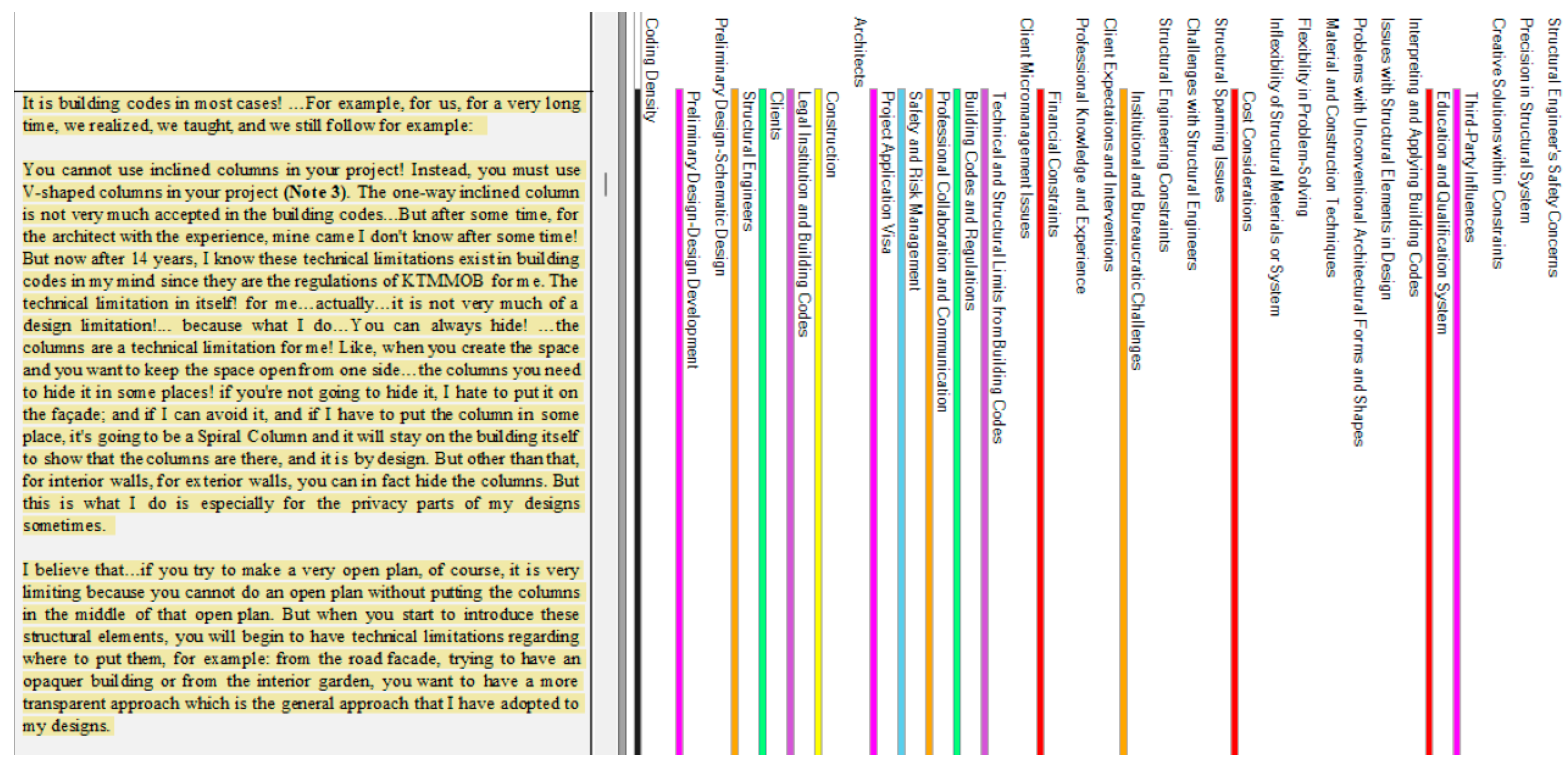
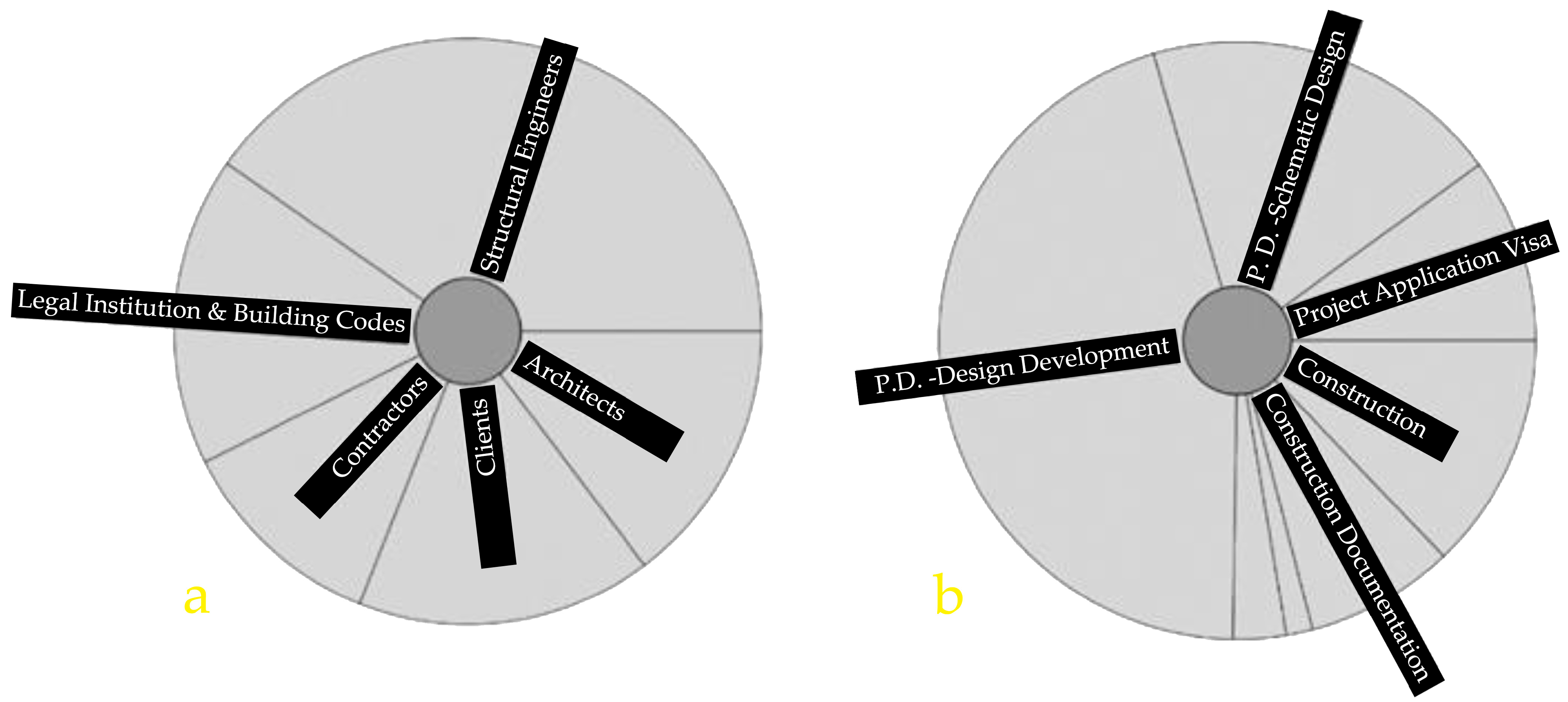
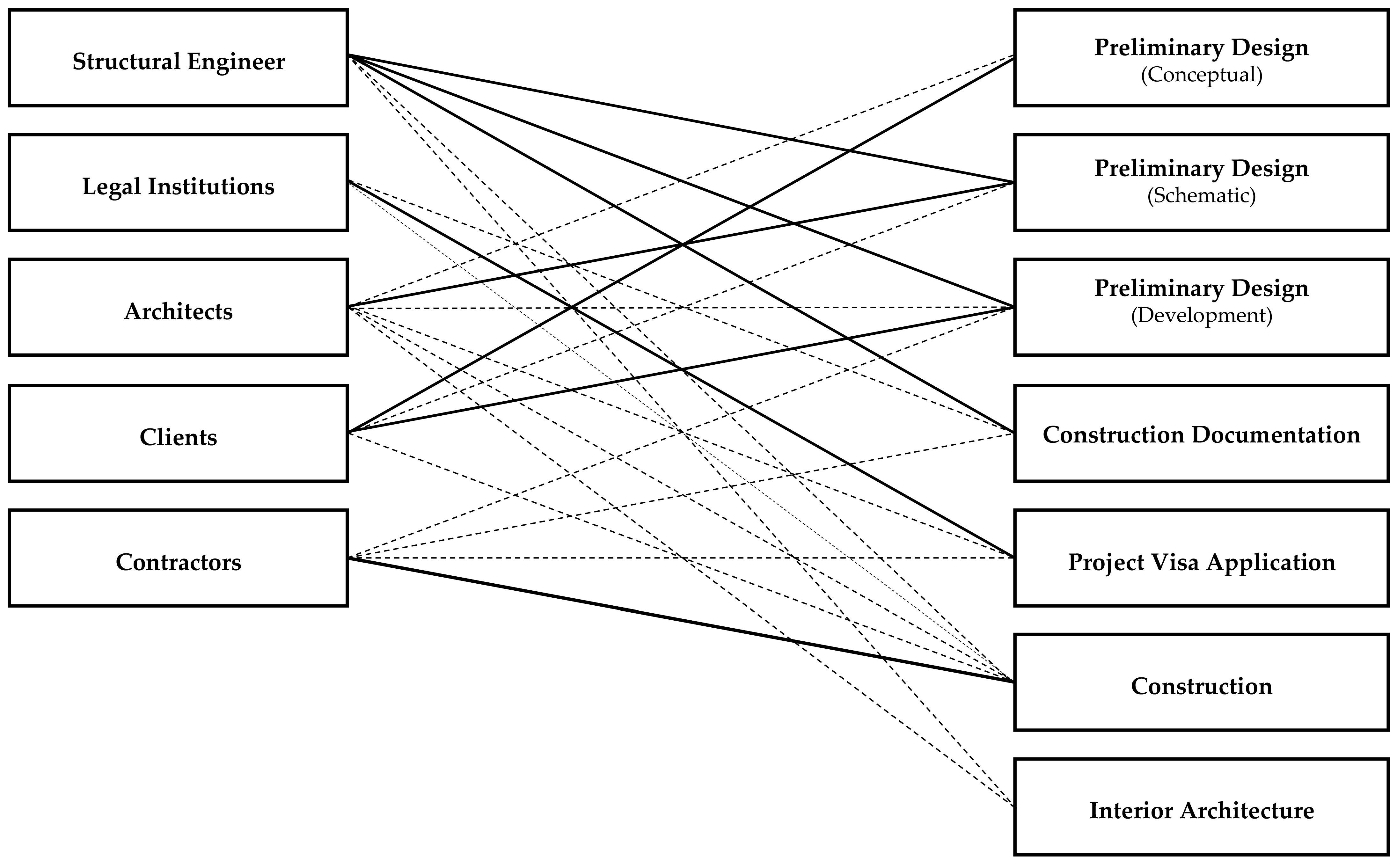
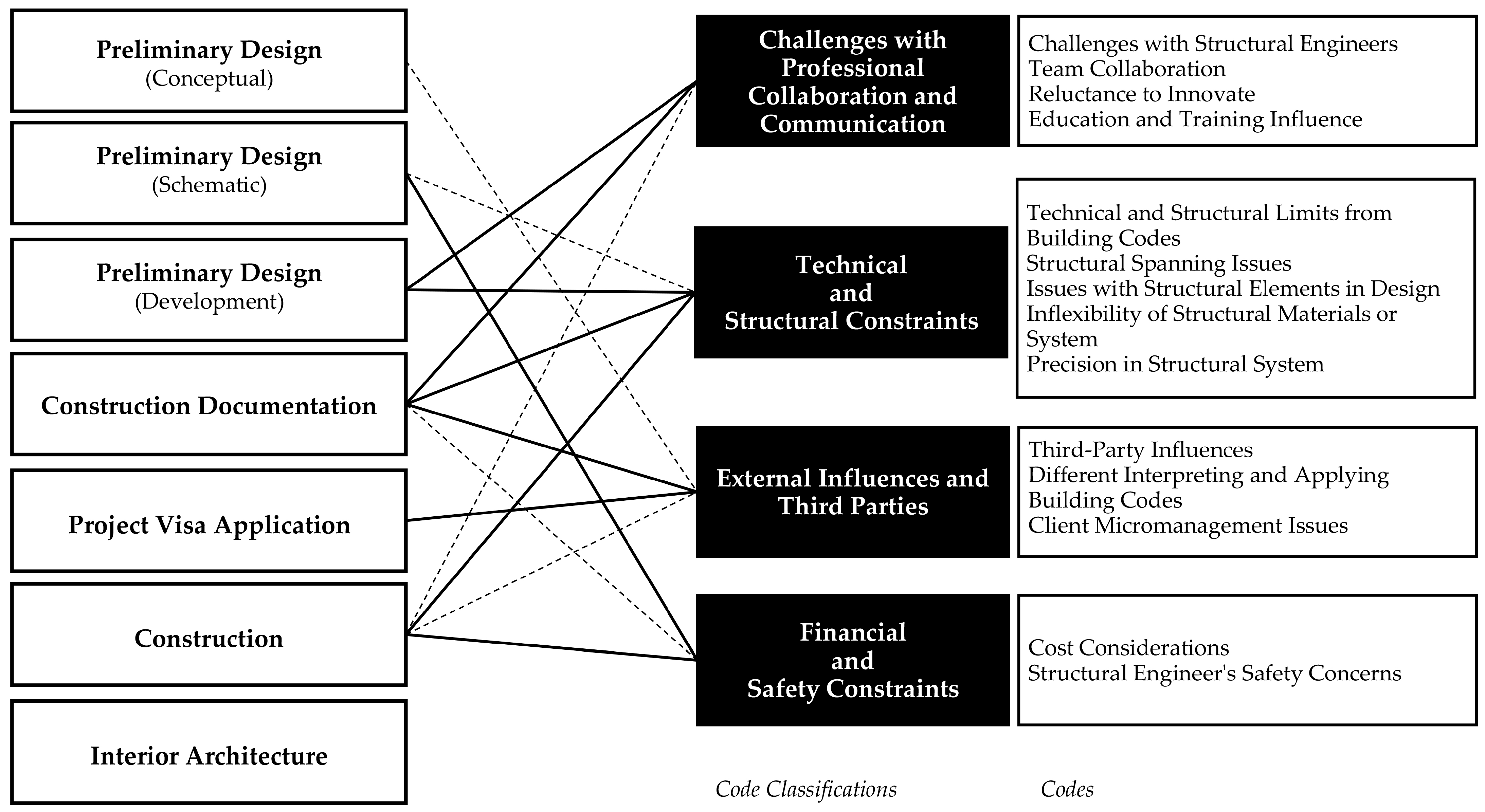






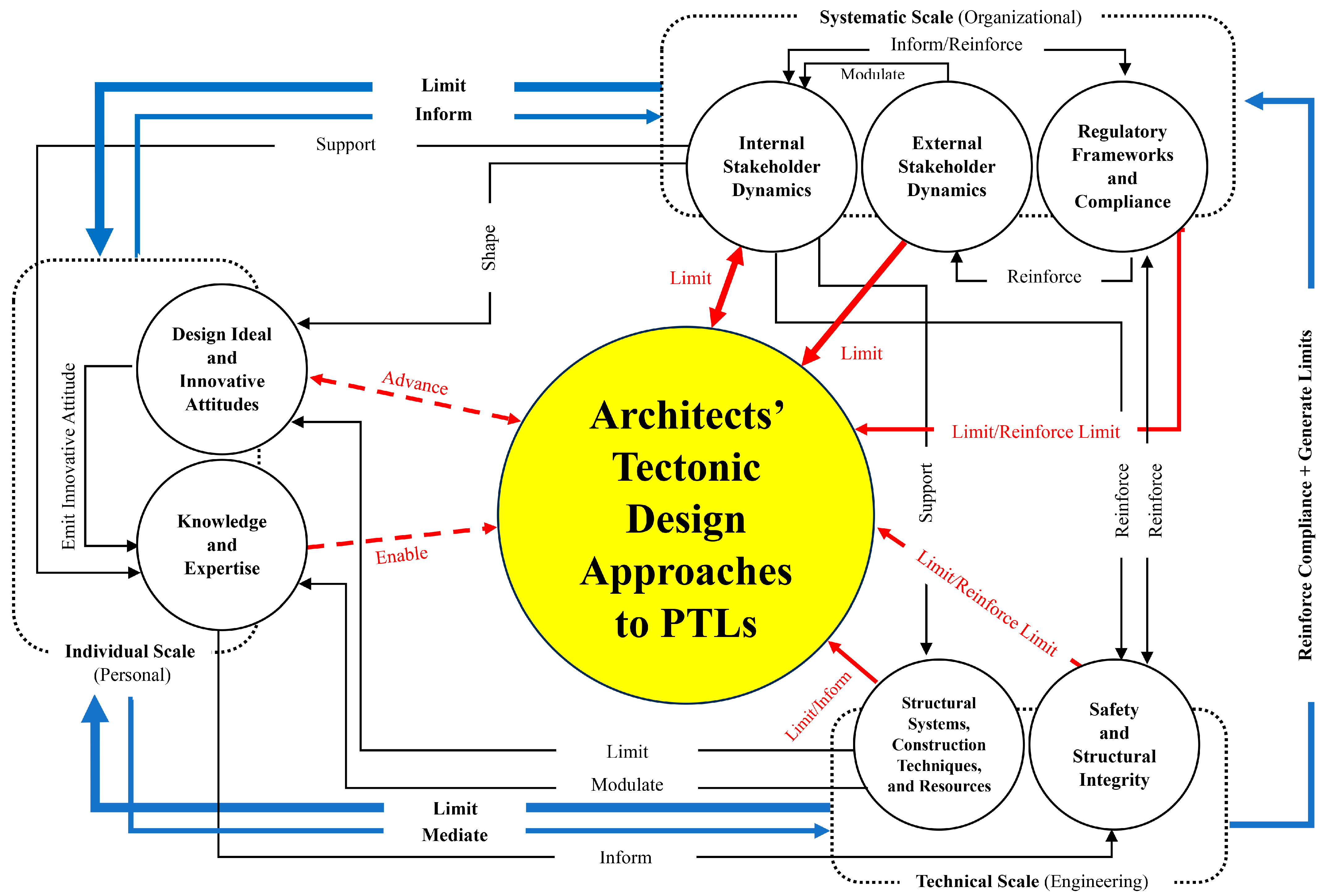
| Tectonic Design Approaches | ||
|---|---|---|
| Affirmative | Contravening | |
| PTL Engagement | Accepting PTLs as a limiting framework and working within their technical boundaries. | Challenging, rejecting, transforming, or replacing PTLs to push design boundaries through innovative solutions. |
| Design Focus | Adhering to natural principles or prescriptive boundaries helps avoid technical challenges and seeks structural and aesthetic coherence. | Innovation and exploration of a transformative event and new paradigms in architecture. Resisting standardization or developing new standards. |
| Architectural Outcome | Preserving tectonic values without challenging norms or introducing significant innovative solutions. | A progressive architectural practice, transforming norms by exploring new materials, techniques, and structural solutions, and embracing the risks and experimentation that produce innovative designs. |
| Strengths | It emphasizes harmony between structure and aesthetics, ensuring safety, functionality, and alignment with technical requirements. | Expanding transformative engagement possibilities with intellectual, technical, structural, and cultural innovation. |
| Challenges | Limiting innovative design attitudes. | A potential clash with institutional conservatism and feasibility. |
| Innovation | No innovative tectonics, but conservative | Innovative tectonics |
| Temporal Dynamics | Early acceptance of PTLs prioritizes schedule certainty; standard solutions accelerate approvals and reduce iteration; mid-project code or client changes are absorbed through compliance adjustments rather than redesign. | Requires extended front-loaded exploration/negotiation; higher risk of delay at visa and construction stages; innovation often depends on the timing of regulatory updates and the willingness of stakeholders to iterate. |
| Stages | Purpose | Instrument/Data | Sampling Frame | Sample Size (n) | Analysis | Outputs/Where Shown | |
|---|---|---|---|---|---|---|---|
| 1 | Survey (quant.) | Validate RQs; confirm presence of PTLs in practice | Online structured questionnaire (closed-ended) | All UCTCEA members in Northern Cyprus | Distributed to 1385; Responses n = 44, of which n = 38 valid (per Figure 1) | SPSS frequencies & cross-tabs | Figure 1a,b; Section 2 (presence/ acceptance of PTLs) |
| 2.1 | Pre-interview (qual. scaffold) | Scope and tailor interview prompts | Brief pre-interview matrix | Interview invitees | Same as Stage 2.2 | Used to refine semi-structured questions | Table 3 (matrix & first insights) |
| 2.2 | Interviews (qual.) | In-depth accounts of PTLs & tectonic approaches | Semi-structured interviews; project docs | UCTCEA architects, National Competition winners (2007–2019; active in practice) | Invited 23; interviewed 11 | NVivo-12 hybrid coding (structural → descriptive → value) + thematic analysis | Figure 2 (Process); Section 5 (coding traces & patterns) |
| Selected UCTCEA Architects | |||||||||||||
|---|---|---|---|---|---|---|---|---|---|---|---|---|---|
| Participant Number | P-01 | P-02 | P-03 | P-04 | P-05 | P-06 | P-07 | P-08 | P-09 | P-10 | P-11 | ||
| No. | Pre-Interview Questions | Firm Size/Type (Based on the number of architects) | Small | Sole | Medium | Sole | Medium | Medium | Medium | Micro | Medium | Large | Medium |
| Typical Project Types | Housing, Mixed-Use, Public | Housing | Housing, Mixed-Use, Public | Housing | Housing, Mixed-Use, Public | Housing, Mixed-Use, Public | Housing, Mixed-Use, Public | Housing, Mixed-Use, Public | Housing, Mixed-Use, Public | Housing, Mixed-Use, Public | Housing, Mixed-Use, Public | ||
| Answers | |||||||||||||
| 1 | I am an architect actively involved in my profession: | Yes | X | X | X | X | X | X | X | X | X | X | X |
| No | |||||||||||||
| 2 | I have been professionally involved with the building process for: | Less than 5 years | |||||||||||
| 5–10 years | |||||||||||||
| 10–20 years | X | X | X | X | X | ||||||||
| More than 20 years | X | X | X | X | X | X | |||||||
| 3 | Have you ever designed or constructed buildings with a frame (skeleton) structure in Northern Cyprus? | Yes | X | X | X | X | X | X | X | X | X | X | X |
| No | |||||||||||||
| 4-1 | Have you ever designed or constructed buildings with a frame (skeleton) structure abroad? | Yes | X | X | X | X | X | ||||||
| No | X | X | X | X | X | X | |||||||
| 4-2 | If (Yes), which countries? | ………….. | United Kingdom | Rep. of Cyprus | Bosnia, Romania, Gabon | Rep. of Cyprus | Rep. of Cyprus, Türkiye | ||||||
| 5-1 | Have you ever encountered PTLs related to the reinforced-concrete frame structure during the building process? | Yes | X | X | X | X | X | X | X | X | X | X | X |
| No | |||||||||||||
| 5-2 | If (Yes), where did you encounter these prescriptive technical limits? (You may choose more than one option) | The Attitudes and/or Subjective Interpretations of Architects (by architect, colleagues, professional community, etc.) | X | X | X | X | X | ||||||
| The Attitudes and/or Rational Interpretations of Structural Engineers | X | X | X | X | X | X | X | X | X | X | |||
| Clients’ Considerations | X | X | X | X | X | ||||||||
| Contractors’ Considerations | X | X | X | X | X | X | X | ||||||
| Considerations of Legal Institutions Overseeing the Building Process | X | X | X | X | X | X | X | ||||||
| Other(s)… | High Cost | ||||||||||||
| Austria | Belgium | Bulgaria | Rep. of Cyprus | Czech Republic | Estonia | Finland | France | Germany | Greece | Hungary | Ireland | Italy | Latvia | Lithuania | Luxembourg | Malta | Netherlands | Poland | Portugal | Romania | Slovakia | Slovenia | Spain | Sweden | UK | Türkiye | Northern Cyprus | |
|---|---|---|---|---|---|---|---|---|---|---|---|---|---|---|---|---|---|---|---|---|---|---|---|---|---|---|---|---|
| Functional | X | O | O | O | ||||||||||||||||||||||||
| Performance | O | O | O | O | O | O | O | O | O | O | O | O | X | X | O | O | O | O | O | O | ||||||||
| Prescriptive | O | O | O | O | O | O | O | O | O | O | O | O | O | O | ||||||||||||||
| N/A | N/A | N/A | N/A | N/A | N/A |
| Hybrid Qualitative Coding Method | ||||||
| STRUCTURAL CODING Deductive Indexing of Qualitative Data INITIATORS/STAGE | DESCRIPTIVE CODING Deductive Indexing of Qualitative Data CAUSES/LIMITS | VALUE CODING Inductive Indexing of Qualitative Data AFFECTS/APPROACHES | ||||
| Initiators of the PTLs | Stages of Appearance of PTLs in the Building Process | Types of PTLs | Root Causes of PTLs | Affects of PTLs on Design | Tectonic Design Approaches | |
| Derived Quote (A sample derived quote: Participant 1) | Generated Groups of Codes | |||||
| [PTLs are rooted in] the building codes in most cases! …For example, for us, for an exceptionally long time, we taught, and we still follow, for example: You cannot use inclined columns in your project! Instead, you must use V-shaped columns in your project. The one-way inclined column is not widely accepted in the building codes. […] Secondly, the building codes by structural engineers and the Chamber of Civil Engineering, according to the earthquake regulations, put technical limits on the design project. […] Lastly, the engineer himself sometimes said I must put a column here, and he would have outbursts at some point because sometimes I want to have them as little as possible. However, to my advantage, we both know the rules of KTMMOB, which allows me to place the columns wherever I want. Together, I have an excellent structural engineer who says, ‘Always, there is no” no “! There is only a price for it.’ …So, we can do anything, but it will cost the construction itself! […] I found that, unless it is an extreme cost, I would not disclose every micromanaging cost to the client. Because they have already come to me for design, they know what they want regarding building standards…And for the reinforced-concrete structure, people are not very attentive to saving money from the reinforced-concrete structure. | Legal Institutions and Building Codes Structural Engineers Clients | Preliminary Design—Design Development Project Application Visa Construction | Technical and Structural Limits from Building Codes Cost Considerations Third-party Influences Fundamental Forces accounted in the Technical and Structural Context | Safety and Risk Management Professional Collaboration and Communication Building Codes and Regulations Financial Constraints Institutional and Bureaucratic Challenges Education and Qualification System | Limitations on Creativity and Innovation Frustration and Conflict Decreased Satisfaction and Compromise in Design Vision Diminished Spatial Qualities | Adaptive Design Strategies Reduced Design Freedom Balancing Aesthetics and Functionality Creative Compromises Leveraging Experience and Expertise |
| Stages of PTLs Manifestation | ||||||||
|---|---|---|---|---|---|---|---|---|
| Preliminary Design (Conceptual) | Preliminary Design (Schematic) | Preliminary Design (Development) | Construction Documentation | Project Visa Application | Construction | Interior Architecture | ||
| Initiators of PTLs | Structural Engineers | 0 | 13 | 29 | 12 | 0 | 6 | 1 |
| Legal Institutions | 0 | 0 | 0 | 7 | 23 | 4 | 0 | |
| Architects | 3 | 12 | 7 | 0 | 5 | 4 | 2 | |
| Clients | 12 | 4 | 10 | 0 | 0 | 5 | 0 | |
| Contractors | 0 | 0 | 2 | 2 | 3 | 14 | 0 | |
| Types of PTLs | |||||
|---|---|---|---|---|---|
| Challenges with Professional Collaboration & Communication | Technical and Structural Constraints | External Influences & Third Parties | Financial & Safety Constraints | ||
| Stages of PTLs Manifestation | Preliminary Design (Conceptual) | 0 | 0 | 0 | 0 |
| Preliminary Design (Schematic) | 0 | 7 | 0 | 33 | |
| Preliminary Design (Development) | 22 | 36 | 0 | 0 | |
| Construction Documentation | 12 | 13 | 11 | ||
| Project Visa Application | 0 | 0 | 39 | 0 | |
| Construction | 0 | 14 | 6 | 21 | |
| Interior Architecture | 0 | 0 | 0 | 0 | |
| Scale | Themes | Description |
|---|---|---|
| Individual Scale (Personal) | Design Ideal and Innovative Attitudes | Architects may balance creative vision with PTLs to pursue innovative solutions that achieve aesthetic goals. They may also prefer affirmative approaches. |
| Knowledge and Expertise | Professional knowledge, expertise, and education inform the design approaches and problem-solving strategies of architects and engineers as they address technical and structural challenges. | |
| Systematic Scale (Organizational) | Internal Stakeholder Dynamics | Internal stakeholders, including architects and structural engineers, influence architectural decisions, balancing design ideals with PTLs. |
| External Stakeholder Dynamics | External stakeholders, including clients, regulatory frameworks, and others, influence architectural decisions by balancing design ideals with their demands, expectations, and PTLs. | |
| Regulatory Frameworks and Compliance | Regulatory frameworks, building codes, and safety standards shape architectural design and define legal structural boundaries. | |
| Technical Scale (Engineering) | Structural Systems, Construction Techniques, and Resources | Financial resources, structural material properties, and reinforced-concrete frame systems critically influence the feasibility and direction of architectural projects. |
| Safety and Structural Integrity | Safety and structural integrity are crucial in architectural design, guiding technical decisions, especially in high-risk environments. |
Disclaimer/Publisher’s Note: The statements, opinions and data contained in all publications are solely those of the individual author(s) and contributor(s) and not of MDPI and/or the editor(s). MDPI and/or the editor(s) disclaim responsibility for any injury to people or property resulting from any ideas, methods, instructions or products referred to in the content. |
© 2025 by the authors. Licensee MDPI, Basel, Switzerland. This article is an open access article distributed under the terms and conditions of the Creative Commons Attribution (CC BY) license (https://creativecommons.org/licenses/by/4.0/).
Share and Cite
Yazdani, K.; Hurol, Y. Technical Limits in Prescriptive Building Cultures and Tectonic Approaches: Challenges of Turkish Cypriot Architects. Buildings 2025, 15, 4220. https://doi.org/10.3390/buildings15234220
Yazdani K, Hurol Y. Technical Limits in Prescriptive Building Cultures and Tectonic Approaches: Challenges of Turkish Cypriot Architects. Buildings. 2025; 15(23):4220. https://doi.org/10.3390/buildings15234220
Chicago/Turabian StyleYazdani, Kamiar, and Yonca Hurol. 2025. "Technical Limits in Prescriptive Building Cultures and Tectonic Approaches: Challenges of Turkish Cypriot Architects" Buildings 15, no. 23: 4220. https://doi.org/10.3390/buildings15234220
APA StyleYazdani, K., & Hurol, Y. (2025). Technical Limits in Prescriptive Building Cultures and Tectonic Approaches: Challenges of Turkish Cypriot Architects. Buildings, 15(23), 4220. https://doi.org/10.3390/buildings15234220







